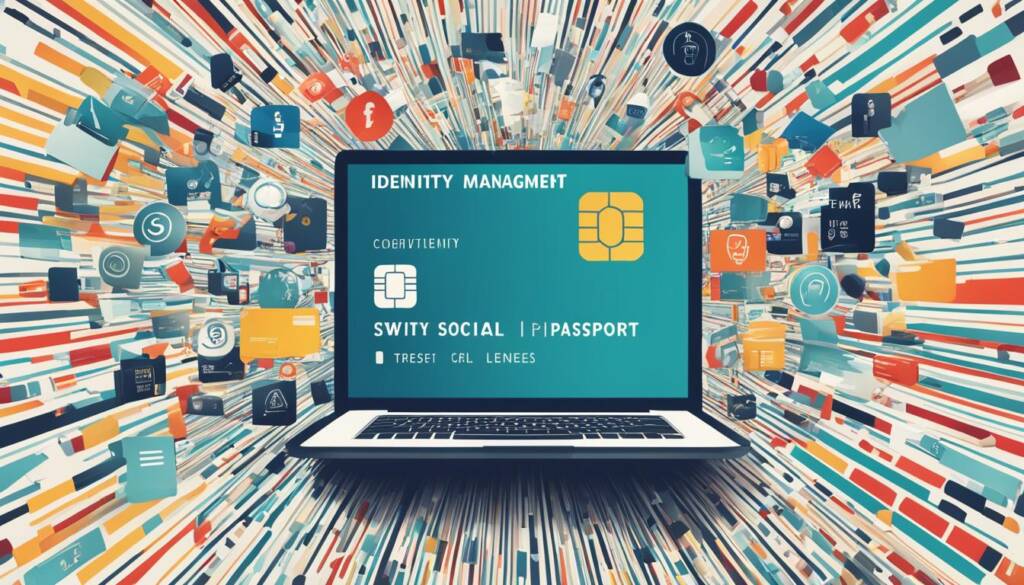Table of Contents
Identity management plays a crucial role in securing personal and corporate data in today’s digital landscape. With the increasing reliance on technology and the growing threats to cybersecurity, organizations need to implement robust systems and processes to protect access to sensitive information.
Identity and access management (IAM) is a comprehensive framework that encompasses the identification of individuals in a system, the assignment of roles and access levels, and the protection of sensitive data. IAM systems can be deployed on-premises, through cloud-based subscriptions, or in a hybrid model.
For businesses, IAM is essential for safeguarding access to corporate resources, automating user privileges, controlling resource access, and complying with regulations. By implementing IAM technologies such as single sign-on systems, two-factor authentication, multifactor authentication, and privileged access management, organizations can fortify their digital defenses and ensure that only authorized individuals have access to critical data.
As the digital landscape continues to evolve, identity management remains a fundamental aspect of cybersecurity. By understanding and implementing effective IAM strategies, organizations can enhance their security posture, mitigate the risk of data breaches, and optimize their operations for continued success.
Components of IAM
On a fundamental level, Identity and Access Management (IAM) encompasses several components that are vital for effective identity management and data protection. These components include:
- Identification: IAM involves how individuals are identified within a system. It focuses on differentiating identity management from authentication, ensuring that individuals’ identities are accurately established and maintained.
- Roles: IAM also involves how roles are identified and assigned to individuals. This component ensures that individuals have the necessary privileges and permissions in accordance with their responsibilities and job functions.
- Administration: IAM includes the processes of adding, removing, and updating individuals and their roles within a system. This enables organizations to efficiently manage user accounts and keep their IAM systems up-to-date.
- Access Levels: IAM encompasses assigning different levels of access to individuals or groups. This component ensures that individuals have access to the resources and data they need to carry out their tasks, while restricting access to sensitive information based on predefined policies.
- Data Protection: Lastly, IAM focuses on protecting sensitive data within the system and securing the system itself. This component ensures that data is encrypted, access controls are in place, and security measures are implemented to safeguard against unauthorized access and data breaches.
IAM systems often incorporate role-based access control, allowing system administrators to better regulate access based on individual user roles within the enterprise. This granular control ensures that users have the appropriate access rights, minimizing the risk of data breaches and unauthorized actions.
By implementing robust IAM components, organizations can effectively manage identities, roles, access levels, and data protection, creating a secure and controlled environment for their digital operations.
Benefits of IAM
IAM technologies offer numerous benefits to organizations, providing enhanced access control, safeguarding against data breaches, promoting efficient operations, ensuring compliance, and giving competitive advantages. Let’s explore these benefits in detail:
1. Access Control
Implementing IAM allows organizations to grant access privileges according to policy. This ensures that individuals and services are properly authenticated, authorized, and audited, reducing the risk of both internal and external data breaches. By enforcing strict access control measures, IAM technology plays a crucial role in safeguarding personal and corporate data.
2. Efficient Operations
Automating IAM systems significantly increases operational efficiency by reducing the effort, time, and cost required for manual access management. With an IAM solution in place, organizations can streamline user onboarding and offboarding processes, simplify role assignments, and automate access provisioning. These streamlined processes result in improved productivity and reduced administrative burden on IT teams.
3. Compliance
IAM tools help organizations enforce security measures and comply with government regulations. They provide policies for user authentication, validation, and privileges, ensuring that corporate information is not misused or accessed by unauthorized individuals. Additionally, IAM systems facilitate the collection and storage of data for auditing purposes, allowing organizations to demonstrate compliance and meet regulatory requirements.
4. Competitive Advantages
Implementing IAM solutions can give companies a competitive edge in the digital landscape. IAM technologies enable secure access to the network for users outside the organization, such as customers and partners. This enhanced collaboration and productivity lead to improved efficiency and reduced costs. By providing seamless and secure access to resources, IAM solutions foster stronger relationships and partnerships, ultimately driving business growth and success.
| Benefit | Description |
|---|---|
| Access Control | Ensures proper authentication, authorization, and auditing, reducing data breach risks. |
| Efficient Operations | Automates access management processes, saving time, effort, and cost. |
| Compliance | Enforces security measures and facilitates regulatory compliance. |
| Competitive Advantages | Enhances collaboration, productivity, efficiency, and reduces costs. |
IAM Technologies and Tools
IAM technologies play a vital role in simplifying user provisioning and account setup processes. These systems streamline and automate these tasks, reducing the time and potential for errors. By implementing controlled workflows and automated account fulfillment, IAM technologies ensure a seamless experience for users.
Effective IAM systems should provide a comprehensive management console with features such as policy definition, reporting, alerts, and alarms. They should also support directory integration, catering to both wired and wireless users. Moreover, IAM technologies need to be flexible to meet the ever-evolving security and operational policy requirements of organizations.
One of the key features of IAM systems is the incorporation of single sign-on technologies. This innovative approach significantly lowers the number of passwords users need to remember while maintaining a high level of security. Additionally, IAM technologies enable access request and approval processes, allowing organizations to customize access privileges based on employee job functions.
IAM technologies leverage various digital authentication methods, including unique passwords, pre-shared keys, behavioral authentication, and biometrics. By implementing these authentication mechanisms, IAM systems ensure that the appropriate access is granted to individuals or devices, thereby enhancing security and boosting productivity within the organization.
FAQ
What is identity management?
Identity management is a framework of business processes, policies, and technologies that facilitate the management of electronic or digital identities. It plays a crucial role in securing personal and corporate data in today’s digital landscape.
What are the components of IAM?
IAM encompasses several components, including the identification of individuals in a system, the assignment of roles to individuals, the addition, removal, and updating of individuals and their roles, the assignment of access levels, and the protection of sensitive data within the system.
What are the benefits of IAM?
IAM provides several benefits to organizations, including access control based on policies, reducing the risk of data breaches, increasing operational efficiency, aiding in security enforcement and compliance with regulations, and providing a competitive advantage through enhanced collaboration and reduced costs.
What technologies and tools are involved in IAM?
IAM technologies and tools involve user provisioning and account setup processes, access rights management, access request and approval processes, single sign-on technologies, and various digital authentication methods such as passwords, pre-shared keys, behavioral authentication, and biometrics.













